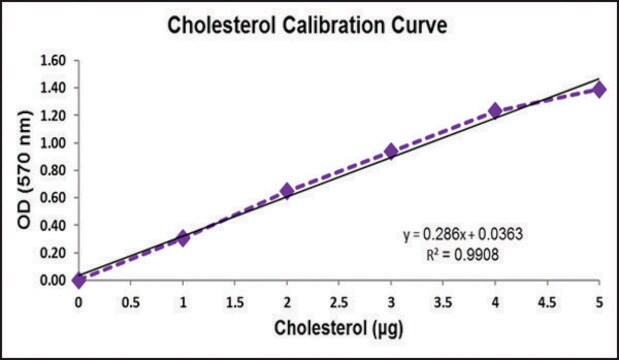TR0100
Kit e reagenti per trigliceridi e glicerolo libero
1 kit sufficient for 250 tests
Sinonimo/i:
Triglyceride and Free Glycerol Kits and Reagents
About This Item
Prodotti consigliati
Cerchi prodotti simili? Visita Guida al confronto tra prodotti
Categorie correlate
Descrizione generale
Applicazioni
Triglycerides are first hydrolyzed by lipoprotein lipase to glycerol and free fatty acids. Glycerol is then phosphorylated by adenosine-5′-triphosphate (ATP) forming glycerol-1-phosphate (G-1-P) and adenosine-5′-diphosphate (ADP) in the reaction catalyzed by glycerol kinase (GK). G-1-P is then oxidized by glycerol phosphate oxidase (GPO) to dihydroxy-acetone phosphate (DAP) and hydrogen peroxide (H2O2). Peroxidase (POD) catalyzes the coupling of H2O2 with 4-aminoantipyrine (4-AAP) and sodium
N-ethyl-N-(3-sulfopropyl) m-anisidine (ESPA) to produce a quinoneimine dye that shows an absorbance maximum at 540 nm. The increase in absorbance at 540 nm is directly proportional to triglyceride concentration of the sample.
Confezionamento
Compatibilità
Principio
Linkage
Standard
Avvertenze
Danger
Indicazioni di pericolo
Consigli di prudenza
Classi di pericolo
Acute Tox. 4 Oral - Aquatic Acute 1 - Aquatic Chronic 1 - Eye Dam. 1 - Skin Irrit. 2
Codice della classe di stoccaggio
11 - Combustible Solids
Punto d’infiammabilità (°F)
Not applicable
Punto d’infiammabilità (°C)
Not applicable
Certificati d'analisi (COA)
Cerca il Certificati d'analisi (COA) digitando il numero di lotto/batch corrispondente. I numeri di lotto o di batch sono stampati sull'etichetta dei prodotti dopo la parola ‘Lotto’ o ‘Batch’.
Possiedi già questo prodotto?
I documenti relativi ai prodotti acquistati recentemente sono disponibili nell’Archivio dei documenti.
I clienti hanno visto anche
Articoli
The potential for the prevention and treatment of cardiovascular disease through increased dietary intake of omega-3 (w-3) fish oils is not a recent scientific discovery.
Lipid Induced Insulin Resistance
Il team dei nostri ricercatori vanta grande esperienza in tutte le aree della ricerca quali Life Science, scienza dei materiali, sintesi chimica, cromatografia, discipline analitiche, ecc..
Contatta l'Assistenza Tecnica.







